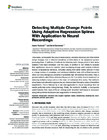Detecting Multiple Change Points Using Adaptive Regression Splines With Application to Neural Recordings
dc.contributor.author
Toutounji, Hazem
dc.contributor.author
Durstewitz, Daniel
dc.date.accessioned
2018-11-21T12:07:27Z
dc.date.available
2018-11-09T05:08:46Z
dc.date.available
2018-11-21T12:07:27Z
dc.date.issued
2018-10-04
dc.identifier.issn
1662-5196
dc.identifier.other
10.3389/fninf.2018.00067
en_US
dc.identifier.uri
http://hdl.handle.net/20.500.11850/302273
dc.identifier.doi
10.3929/ethz-b-000302273
dc.description.abstract
Time series, as frequently the case in neuroscience, are rarely stationary, but often exhibit abrupt changes due to attractor transitions or bifurcations in the dynamical systems producing them. A plethora of methods for detecting such change points in time series statistics have been developed over the years, in addition to test criteria to evaluate their significance. Issues to consider when developing change point analysis methods include computational demands, difficulties arising from either limited amount of data or a large number of covariates, and arriving at statistical tests with sufficient power to detect as many changes as contained in potentially high-dimensional time series. Here, a general method called Paired Adaptive Regressors for Cumulative Sum is developed for detecting multiple change points in the mean of multivariate time series. The method's advantages over alternative approaches are demonstrated through a series of simulation experiments. This is followed by a real data application to neural recordings from rat medial prefrontal cortex during learning. Finally, the method's flexibility to incorporate useful features from state-of-the-art change point detection techniques is discussed, along with potential drawbacks and suggestions to remedy them.
en_US
dc.format
application/pdf
en_US
dc.language.iso
en
en_US
dc.publisher
Frontiers Media
dc.rights.uri
http://creativecommons.org/licenses/by/4.0/
dc.subject
change point
en_US
dc.subject
cumulative sum
en_US
dc.subject
adaptive regression splines
en_US
dc.subject
nonstationary
en_US
dc.subject
bootstrap test
en_US
dc.subject
blockpermutation
en_US
dc.subject
behavior
en_US
dc.subject
spike counts
en_US
dc.title
Detecting Multiple Change Points Using Adaptive Regression Splines With Application to Neural Recordings
en_US
dc.type
Journal Article
dc.rights.license
Creative Commons Attribution 4.0 International
ethz.journal.title
Frontiers in Neuroinformatics
ethz.journal.volume
12
en_US
ethz.journal.abbreviated
Front. neuroinform.
ethz.pages.start
67
en_US
ethz.size
17 p.
en_US
ethz.version.deposit
publishedVersion
en_US
ethz.identifier.wos
ethz.publication.place
Lausanne
ethz.publication.status
published
en_US
ethz.date.deposited
2018-11-09T05:08:51Z
ethz.source
WOS
ethz.eth
yes
en_US
ethz.availability
Open access
en_US
ethz.rosetta.installDate
2018-11-21T12:07:35Z
ethz.rosetta.lastUpdated
2024-02-02T06:39:13Z
ethz.rosetta.versionExported
true
ethz.COinS
ctx_ver=Z39.88-2004&rft_val_fmt=info:ofi/fmt:kev:mtx:journal&rft.atitle=Detecting%20Multiple%20Change%20Points%20Using%20Adaptive%20Regression%20Splines%20With%20Application%20to%20Neural%20Recordings&rft.jtitle=Frontiers%20in%20Neuroinformatics&rft.date=2018-10-04&rft.volume=12&rft.spage=67&rft.issn=1662-5196&rft.au=Toutounji,%20Hazem&Durstewitz,%20Daniel&rft.genre=article&rft_id=info:doi/10.3389/fninf.2018.00067&
Dateien zu diesem Eintrag
Publikationstyp
-
Journal Article [128831]

